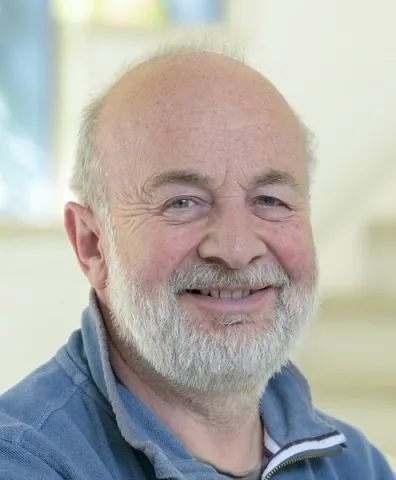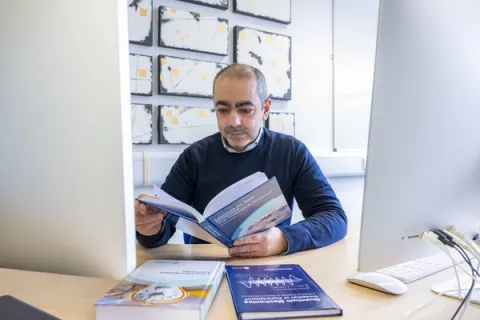Project overview
Nuclear Magnetic Resonance (NMR) is a technique which uses the fact that the nuclei of many atoms act as tiny radiotransmitters, emitting radio signals at precisely-defined frequencies, which can be detected by a carefully-tuned detector. In an NMR experiment, the nuclei are first magnetised by placing a sample in a strong magnetic field for some time. A sequence of radiofrequency pulses is then applied to the sample, which subsequently emits radiowaves which are detected in the radio receiver. The pattern of emitted waves provides information on the chemical composition and spatial distribution of the sample.
Magnetic nuclei may be viewed as small bar magnets, which may point in any direction in space. In normal circumstances the directions in which the nuclear magnets point are almost uniformly distributed, meaning that all directions are almost equally likely. As a result the net nuclear magnetism almost completely cancels out. However, when a strong magnetic field is applied, there is a very small change in this distribution, so that slightly more nuclei point along the applied field, than opposite to it. A very small net magnetism is developed along the applied field, and this is used to generate NMR and MRI signals.
It is possible to generate materials with strongly perturbed nuclear spin distributions. There are two different types of non-equilibrium nuclear spin states.
In the first type, the nuclei are strongly lined up in one direction, to a degree which is much greater than that which is available without intervention. Such materials are said to be hyperpolarized. Materials in hyperpolarized states can generate NMR signals which are 100000 stronger than normal. This phenomenon has already been used in clinical trials for the detection of cancer in human patients.
In the second type of non-equilibrium spin state, neighbouring nuclei in the same molecule are strongly aligned with other, as opposed to being aligned along an external direction. In sufficiently symmetrical molecules, this leads to the phenomenon of spin isomerism, in which compounds with different nuclear spin configurations behave as separate physical substances, which can be stable for a long time. The seminal case is hydrogen gas (H2) where the spin isomers are called ortho and parahydrogen. These spin isomers were predicted to exist by Heisenberg (for which he was awarded a Nobel prize) and their existence is one of the triumphs of quantum mechanics. Recently our group showed that ordinary water may also exhibit ortho and para spin isomers, providing the water molecules are trapped inside carbon cages (fullerenes) so that they are free to rotate at low temperature. We also showed that the type of water spin isomer has an influence on the electrical properties of the material.
In this Platform Grant we will further develop the sciences of hyperpolarization and spin isomerism and explore how they relate to each other. In some circumstances, spin isomerism may lead to hyperpolarization, and vice versa. By conducting this research we will learn a great deal about the behaviour of magnetic nuclei in symmetrical molecules, and develop new methods for enhancing NMR signals by enormous factors, which will have an impact on a wide range of sciences, including clinical medicine and the detection and characterisation of cancer.
The new science of materials in nuclear spin states which are far from equilibrium also offers commercial opportunities in the form of novel MRI (magnetic resonance imaging) technology, and hyperpolarized imaging agents.
During the project we will give our research team the opportunity to work flexibly and interactively across several interlocking disciplines. An innovation fund with an internal bidding process will be instituted to allow the participating researchers to explore their own ideas and to visit other laboratories.
Magnetic nuclei may be viewed as small bar magnets, which may point in any direction in space. In normal circumstances the directions in which the nuclear magnets point are almost uniformly distributed, meaning that all directions are almost equally likely. As a result the net nuclear magnetism almost completely cancels out. However, when a strong magnetic field is applied, there is a very small change in this distribution, so that slightly more nuclei point along the applied field, than opposite to it. A very small net magnetism is developed along the applied field, and this is used to generate NMR and MRI signals.
It is possible to generate materials with strongly perturbed nuclear spin distributions. There are two different types of non-equilibrium nuclear spin states.
In the first type, the nuclei are strongly lined up in one direction, to a degree which is much greater than that which is available without intervention. Such materials are said to be hyperpolarized. Materials in hyperpolarized states can generate NMR signals which are 100000 stronger than normal. This phenomenon has already been used in clinical trials for the detection of cancer in human patients.
In the second type of non-equilibrium spin state, neighbouring nuclei in the same molecule are strongly aligned with other, as opposed to being aligned along an external direction. In sufficiently symmetrical molecules, this leads to the phenomenon of spin isomerism, in which compounds with different nuclear spin configurations behave as separate physical substances, which can be stable for a long time. The seminal case is hydrogen gas (H2) where the spin isomers are called ortho and parahydrogen. These spin isomers were predicted to exist by Heisenberg (for which he was awarded a Nobel prize) and their existence is one of the triumphs of quantum mechanics. Recently our group showed that ordinary water may also exhibit ortho and para spin isomers, providing the water molecules are trapped inside carbon cages (fullerenes) so that they are free to rotate at low temperature. We also showed that the type of water spin isomer has an influence on the electrical properties of the material.
In this Platform Grant we will further develop the sciences of hyperpolarization and spin isomerism and explore how they relate to each other. In some circumstances, spin isomerism may lead to hyperpolarization, and vice versa. By conducting this research we will learn a great deal about the behaviour of magnetic nuclei in symmetrical molecules, and develop new methods for enhancing NMR signals by enormous factors, which will have an impact on a wide range of sciences, including clinical medicine and the detection and characterisation of cancer.
The new science of materials in nuclear spin states which are far from equilibrium also offers commercial opportunities in the form of novel MRI (magnetic resonance imaging) technology, and hyperpolarized imaging agents.
During the project we will give our research team the opportunity to work flexibly and interactively across several interlocking disciplines. An innovation fund with an internal bidding process will be instituted to allow the participating researchers to explore their own ideas and to visit other laboratories.
Staff
Lead researchers
Other researchers
Collaborating research institutes, centres and groups
Research outputs
Ali Sufyan , Tyler James, Connor Fields, Shabnam Naseri, Filipe Junqueira, Sofia Alonso Perez, Sally Bloodworth, Gabriela Hoffman, Mark C Walkey, Elizabeth S Marsden, Richard J. Whitby, Yitao Wang, David A. Duncan, Tien-Lin Lee, James n. O’shea, J Andreas Larsson, Brian Kiraly & Philip Moriarty,
2025, Nanoscale Adv., 7(24), 7913-7929
DOI: 10.1039/D5NA00727E
Type: article
Harry Harbor-Collins, Mohamed Sabba, Christian Bengs, Gamal Moustafa, Markus Leutzsch & Malcolm H. Levitt,
2024, Journal of Chemical Physics, 160(1)
DOI: 10.1063/5.0182233
Type: article
Harry Harbor-Collins, Mohamed Sabba, Gamal Moustafa, Bonifac Legrady, Murari Soundararajan, Markus Leutzsch & Malcolm H. Levitt,
2023, Journal of Chemical Physics, 159(10)
DOI: 10.1063/5.0165830
Type: article
David E. Korenchan, Jiaqi Lu, Mohamed Sabba, Laurynas Dagys, Lynda J. Brown, Malcolm H. Levitt & Alexej Jerschow,
2022, Physical Chemistry Chemical Physics, 24(39), 24239-24246
DOI: 10.1039/d2cp03801c
Type: article
Sally Bloodworth & Richard J. Whitby,
2022, Communications Chemistry, 5(1)
Type: review
Mohamed Sabba, Nino Wili, Christian Bengs, James W. Whipham, Lynda J. Brown & Malcolm H. Levitt,
2022, Journal of Chemical Physics, 157(13)
DOI: 10.1063/5.0103122
Type: article
Gabriela Hoffman, George R. Bacanu, Elizabeth Marsden, Mark Walkey, Mohamed Sabba, Sally Bloodworth, Graham J. Tizzard, Malcolm H. Levitt & Richard J. Whitby,
2022, Chemical Communications, 2022(80), 11284-11287
DOI: 10.1039/D2CC03398D
Type: article



